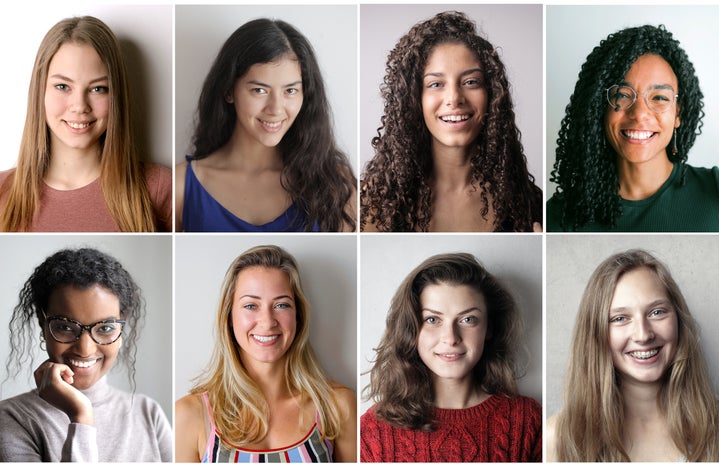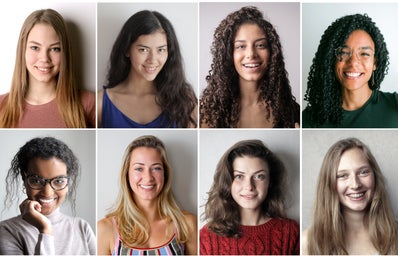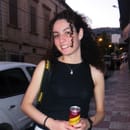In 2016, makeup trends favored bold statements and transformative looks, with flashy, intense smokey eyes, clean cut creases, heavy contouring, matte foundations, and thick matte liquid lips dominating the scene. This trend was associated with 2010s “baddie” culture, characterized by bold, edgy looks that exude confidence and attitude. This aesthetic extends beyond makeup to encompass fashion, with form-fitting clothing, crop tops, high-waisted bottoms, and statement accessories completing the look.
However, today’s makeup trends have shifted towards a more natural aesthetic, with a focus on enhancing one’s inherent beauty. Brands like Glossier epitomize this shift, promoting minimalism and authenticity. Instead of heavily sculpted features, the emphasis is on embracing individuality, with laminated bushy brows, glossy lips, glowing/dewy skin, and rosy cheeks taking center stage. This trend is often associated with the minimalist elegance of Copenhagen aesthetics. Influenced by Scandinavian style and lifestyle, the clean girl trend emphasizes simplicity, functionality, and a natural approach to beauty. Brands like those associated with Matilda Djerf epitomize this aesthetic, focusing on clean lines, neutral color palettes, and high-quality materials.
Discussions in online beauty culture have pivoted towards advocating for less makeup and purportedly embracing natural beauty, displacing the prior dominance of the “Baddie” culture from the 2010s. There is undoubtedly a shift occurring towards a new era of beauty trends that encourage women to celebrate their inherent features. However, I question whether this transition truly represents an era of “self-acceptance.” Rather, it seems to prioritize the enhancement of perceived biological attributes over authentic self-acceptance.
The natural beauty trend, while emphasizing specific biological features that cannot be achieved solely through makeup, has become a focal point in today’s beauty culture. It promotes an idealized image centered around attributes like clear skin, symmetrical facial features, and lush, well-groomed brows and lashes. This trend contrasts with previous makeup-centric approaches, encouraging individuals to embrace and accentuate their inherent features rather than relying on heavy cosmetic enhancements. However, despite its emphasis on authenticity, the natural beauty trend still perpetuates certain standards and ideals. Today’s discussions revolve around creating personalized beauty standards, with memes asking, “Are you cat pretty, bunny pretty, deer pretty, or fox pretty?” and filters allowing users to experiment with each look. Additionally, inquiries delve into concepts like “high or low visual weight,” further shaping these evolving beauty norms. While these discussions may seem to promote self-acceptance and inclusivity, they often prioritize the elevation of perceived biological capital over genuine authenticity and self-acceptance.
It is clear that the current state of beauty culture is evolving, partly due to the diminishing popularity of high glam makeup. Instead of relying solely on makeup techniques to create glamorous and often theatrical looks, there’s now an expectation to achieve beauty from within, akin to crafting the perfect facial structure using a Gua Sha instead of contour. Heavy and noticeable makeup is no longer as fashionable or desirable as it once was. Instead, makeup enthusiasts are leaning towards crafting the perfect “no makeup” look. This approach involves using makeup subtly and skillfully to enhance features while maintaining a natural appearance. It’s about achieving a flawless complexion, enhancing the eyes and brows, and adding a touch of color to the lips and cheeks in a way that appears effortless and understated. This shift can be understood as a cultural evolution in beauty standards, moving from ironic or exaggerated representations of beauty to a more detached,and supposedly laid-back approach. While the ideal of being naturally attractive has always been central to beauty culture, the current emphasis on “natural beauty” perpetuates an unattainable standard. This ideal suggests an inherent beauty inaccessible to most, achieved through artificial means that strive to mimic a contrived natural appearance.
The no makeup look embodies a casual, effortless aesthetic that is increasingly favored in contemporary beauty culture. It suggests a natural radiance and an appearance untouched by cosmetics, resonating with a laid-back vibe. However, beneath this facade lies a paradox: achieving the no makeup look often demands meticulous effort and skillful product application. From rigorous and expensive skincare regimens aimed at achieving flawless complexions to strategic makeup application to enhance natural features, attaining this look requires considerable dedication. The dilemma arises from the disparity between the perceived ease of the no makeup look and the actual labor invested in it. While aspiring to appear effortlessly flawless, individuals are often compelled to invest significant time, effort, and resources into their beauty routines, perpetuating feelings of inadequacy and fueling a cycle of perfectionism. While the no makeup look seems to celebrate authenticity and natural beauty, it just underscores the complexities and pressures inherent in the pursuit of perfection in contemporary beauty standards.
The TikTok trend where users determine if they’re “cat pretty, bunny pretty, deer pretty, or fox pretty” using examples represents a concerning phenomenon within beauty culture. Memes and TikTok content relating to this trend prompt young women to evaluate their skeletal structure and facial features by juxtaposing them with (often digitally altered) images of Instagram models and 90s runway icons. This comparison aims to categorize individuals into perceived superior labels based on physical appearance. By reducing complex and subjective notions of beauty to a simplistic categorization, this trend trivializes and oversimplifies the concept of attractiveness. It turns beauty standards into a deceptively cute game, obscuring the underlying pressure and insecurity that many individuals feel about their appearance. Moreover, the existence of TikTok filters designed to determine one’s “pretty” category further exacerbates this issue by perpetuating unrealistic beauty ideals and promoting comparison among users. These filters not only reinforce narrow beauty standards but also contribute to the harmful belief that one’s worth is determined by their appearance. Ultimately, while social media trends like these may seem innocuous on the surface, they have the potential to perpetuate damaging beauty standards and negatively impact individuals’ self-esteem and mental well-being.
The evolution of beauty standards, particularly in relation to the shift from emphasizing makeup skills to ideals of biological superiority, draws parallels to past trends such as the Tumblr thigh gap phenomenon. During the height of this trend, many young girls resorted to extreme measures, including starvation diets and excessive exercise, in pursuit of achieving a thigh gap – the space between the thighs when standing with feet together. However, what became evident was that the attainment of a thigh gap was not solely dependent on weight loss or thinness, but rather on an individual’s bone structure, particularly the width of their hips. Despite the dangerous lengths to which some went to achieve this idealized aesthetic, the inherent physical differences among individuals meant that a thigh gap remained unattainable for many, regardless of their efforts. Similarly, the contemporary beauty standards that prioritize notions of biological superiority perpetuate unattainable ideals that may be inherently exclusive and unrealistic for a vast majority of people. This underscores the importance of promoting body positivity and embracing diversity in beauty, recognizing that beauty comes in various forms and cannot be confined to narrow and often unattainable standards dictated by societal trends.
In 2016, the unattainability of makeup and beauty standards stemmed from the necessity for strong makeup skills. Achieving the desired look often demanded mastery of intricate techniques such as precise contouring, intricate eyeshadow blending, and perfectly applied liquid lipstick. Influencers like James Charles, Kylie Jenner, and many more dominated this scene. The idealized images showcased on social media platforms like Instagram presented a standard that required not only access to high-quality products but also considerable skill in their application. However, in contrast to this emphasis on technical proficiency, contemporary beauty standards introduce a different form of unattainability. Rather than being solely dependent on makeup skills, the perceived unattainability now arises from notions of eugenics or biological superiority. The idealized beauty image often privileges specific physical traits such as symmetrical facial features, clear skin, and a certain body type, which may be attributed to genetic factors rather than makeup expertise. This shift in unattainability underscores a broader societal fixation on natural beauty and biological determinism, perpetuating unrealistic standards that are inherently exclusionary and unattainable for many individuals.
In the past, beauty standards were often characterized by a singular ideal that everyone strived to achieve. However, in contemporary times, there has been a notable shift towards a proliferation of niche micro-aesthetics, each with their own distinct names and characteristics. These micro-aesthetics encompass a wide range of styles and preferences, catering to diverse tastes and identities. It’s not uncommon to witness the emergence of new trends that are essentially rebranded versions of existing ones, such as labeling burgundy nails as “cherry mocha” to create a fresh appeal. This trend towards niche micro-aesthetics reflects a growing desire for individuality and personal expression within the realm of beauty.
The “what type of pretty am I” trend epitomizes this phenomenon by attempting to categorize individuals into specific beauty archetypes, such as “cat pretty,” “bunny pretty,” “deer pretty,” or “fox pretty.” While these categories may seem distinct, they often overlap and share similarities, ultimately reinforcing existing beauty standards rather than challenging them. Moreover, this trend can be seen as a continuation of the broader trend towards niche micro-aesthetics, where even the slightest variation in appearance is given a specific label.
The emerging natural beauty trend is not a genuine celebration of one’s natural self; rather, it represents a strategic shift in consumer spending from makeup to skin care and preventative procedures like botox injections. This transition is evident in the decreasing popularity of items like the Kylie Jenner lip kit or the Naked eyeshadow palette, which were once coveted staples of the beauty industry. Instead, consumers are increasingly investing in skincare products and treatments aimed at achieving a more youthful and radiant complexion. However, it’s crucial to recognize that the primary beneficiaries of these trends are celebrities and influencers who possess the means to access the latest makeup, skincare products, and procedures. These individuals perpetuate the notion that by emulating their routines and appearances, consumers can attain similar levels of beauty and success. Despite the allure of going makeup-free and embracing a more natural look, it’s important to acknowledge that this shift does not equate to progress in feminism or the dismantling of traditional beauty standards. Instead, it serves to reinforce existing societal norms by promoting certain beauty ideals and perpetuating consumerism within the industry.


